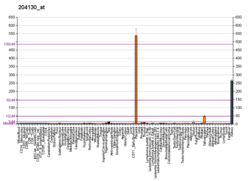Corticosteroid 11-beta-dehydrogenase isozyme 2
Corticosteroid 11-β-dehydrogenase isozyme 2 also known as 11-β-hydroxysteroid dehydrogenase 2 is an enzyme that in humans is encoded by the HSD11B2 gene.[5][6][7]
Function
Corticosteroid 11-β-dehydrogenase isozyme 2 is an NAD+-dependent enzyme expressed in aldosterone-selective epithelial tissues such as the kidney, colon, salivary and sweat glands. HSD211B2 expression is also found in the brainstem in a small, aldosterone-sensitive subset of neurons located in the nucleus of the solitary tract referred to as HSD2 neurons.[8]
In these tissues, HSD11B2 oxidizes the glucocorticoid cortisol to the inactive metabolite cortisone, thus preventing illicit activation of the mineralocorticoid receptor. This protective mechanism is necessary because cortisol circulates at 100- to 1000-fold higher concentrations than aldosterone, and binds with equal affinity to the mineralocorticoid receptor, thereby out-competing aldosterone in cells that do not produce HSD11B2.
This glucocorticoid-inactivating enzyme is also expressed in tissues that do not express the mineralocorticoid receptor, such as the placenta and testis, as well as parts of the developing brain, including the rhombencephalic progenitor cells that proliferate into cerebellar granule cells. In these tissues, HSD11B2 protects cells from the growth-inhibiting and/or pro-apoptotic effects of cortisol, particularly during embryonic development.
Clinical significance
Inhibition of this enzyme, for example by a compound in liquorice, results in a condition known as pseudohyperaldosteronism. A genetically inherited deficiency of HSD11B2 is the underlying cause of the syndrome of apparent mineralocorticoid excess.
References
- GRCh38: Ensembl release 89: ENSG00000176387 - Ensembl, May 2017
- GRCm38: Ensembl release 89: ENSMUSG00000031891 - Ensembl, May 2017
- "Human PubMed Reference:". National Center for Biotechnology Information, U.S. National Library of Medicine.
- "Mouse PubMed Reference:". National Center for Biotechnology Information, U.S. National Library of Medicine.
- Albiston AL, Obeyesekere VR, Smith RE, Krozowski ZS (November 1994). "Cloning and tissue distribution of the human 11 beta-hydroxysteroid dehydrogenase type 2 enzyme". Mol. Cell. Endocrinol. 105 (2): R11–7. doi:10.1016/0303-7207(94)90176-7. PMID 7859916.
- Brown RW, Chapman KE, Kotelevtsev Y, Yau JL, Lindsay RS, Brett L, Leckie C, Murad P, Lyons V, Mullins JJ, Edwards CR, Seckl JR (February 1996). "Cloning and production of antisera to human placental 11 beta-hydroxysteroid dehydrogenase type 2". Biochem. J. 313 (Pt 3): 1007–17. doi:10.1042/bj3131007. PMC 1216963. PMID 8611140.
- "Entrez Gene: HSD11B2 hydroxysteroid (11-beta) dehydrogenase 2".
- Geerling, Joel C.; Arthur D. Loewy (September 2009). "Aldosterone in the brain". American Journal of Physiology. Renal Physiology. 297 (3): F559–76. doi:10.1152/ajprenal.90399.2008. PMC 2739715. PMID 19261742.
Further reading
- White PC, Mune T, Agarwal AK (1997). "11 beta-Hydroxysteroid dehydrogenase and the syndrome of apparent mineralocorticoid excess". Endocr. Rev. 18 (1): 135–56. doi:10.1210/er.18.1.135. PMID 9034789.
- Wilson RC, Dave-Sharma S, Wei JQ, et al. (1998). "A genetic defect resulting in mild low-renin hypertension". Proc. Natl. Acad. Sci. U.S.A. 95 (17): 10200–5. doi:10.1073/pnas.95.17.10200. PMC 21485. PMID 9707624.
- Quinkler M, Stewart PM (2003). "Hypertension and the cortisol-cortisone shuttle". J. Clin. Endocrinol. Metab. 88 (6): 2384–92. doi:10.1210/jc.2003-030138. PMID 12788832.
- Tomlinson JW, Walker EA, Bujalska IJ, et al. (2005). "11beta-hydroxysteroid dehydrogenase type 1: a tissue-specific regulator of glucocorticoid response". Endocr. Rev. 25 (5): 831–66. doi:10.1210/er.2003-0031. PMID 15466942.
- Persu A (2005). "11beta-Hydroxysteroid deshydrogenase: a multi-faceted enzyme". J. Hypertens. 23 (1): 29–31. doi:10.1097/00004872-200501000-00007. PMID 15643119.
- Funder JW, Pearce PT, Smith R, Smith AI (1988). "Mineralocorticoid action: target tissue specificity is enzyme, not receptor, mediated". Science. 242 (4878): 583–5. doi:10.1126/science.2845584. PMID 2845584.
- Stewart PM, Wallace AM, Valentino R, et al. (1987). "Mineralocorticoid activity of liquorice: 11-beta-hydroxysteroid dehydrogenase deficiency comes of age". Lancet. 2 (8563): 821–4. doi:10.1016/S0140-6736(87)91014-2. PMID 2889032.
- Wilson RC, Harbison MD, Krozowski ZS, et al. (1995). "Several homozygous mutations in the gene for 11 beta-hydroxysteroid dehydrogenase type 2 in patients with apparent mineralocorticoid excess". J. Clin. Endocrinol. Metab. 80 (11): 3145–50. doi:10.1210/jc.80.11.3145. PMID 7593417.
- Wilson RC, Krozowski ZS, Li K, et al. (1995). "A mutation in the HSD11B2 gene in a family with apparent mineralocorticoid excess". J. Clin. Endocrinol. Metab. 80 (7): 2263–6. doi:10.1210/jc.80.7.2263. PMID 7608290.
- Krozowski Z, Baker E, Obeyesekere V, Callen DF (1995). "Localization of the gene for human 11 beta-hydroxysteroid dehydrogenase type 2 (HSD11B2) to chromosome band 16q22". Cytogenet. Cell Genet. 71 (2): 124–5. doi:10.1159/000134089. PMID 7656579.
- Mune T, Rogerson FM, Nikkilä H, et al. (1995). "Human hypertension caused by mutations in the kidney isozyme of 11 beta-hydroxysteroid dehydrogenase". Nat. Genet. 10 (4): 394–9. doi:10.1038/ng0895-394. PMID 7670488.
- Agarwal AK, Rogerson FM, Mune T, White PC (1996). "Gene structure and chromosomal localization of the human HSD11K gene encoding the kidney (type 2) isozyme of 11 beta-hydroxysteroid dehydrogenase". Genomics. 29 (1): 195–9. doi:10.1006/geno.1995.1231. PMID 8530071.
- Krozowski Z, Albiston AL, Obeyesekere VR, et al. (1996). "The human 11 beta-hydroxysteroid dehydrogenase type II enzyme: comparisons with other species and localization to the distal nephron". J. Steroid Biochem. Mol. Biol. 55 (5–6): 457–64. doi:10.1016/0960-0760(95)00194-8. PMID 8547170.
- Brown RW, Chapman KE, Murad P, et al. (1996). "Purification of 11 beta-hydroxysteroid dehydrogenase type 2 from human placenta utilizing a novel affinity labelling technique". Biochem. J. 313 (Pt 3): 997–1005. doi:10.1042/bj3130997. PMC 1217009. PMID 8611186.
- Kitanaka S, Katsumata N, Tanae A, et al. (1998). "A new compound heterozygous mutation in the 11 beta-hydroxysteroid dehydrogenase type 2 gene in a case of apparent mineralocorticoid excess". J. Clin. Endocrinol. Metab. 82 (12): 4054–8. doi:10.1210/jc.82.12.4054. PMID 9398712.
- Dave-Sharma S, Wilson RC, Harbison MD, et al. (1998). "Examination of genotype and phenotype relationships in 14 patients with apparent mineralocorticoid excess". J. Clin. Endocrinol. Metab. 83 (7): 2244–54. doi:10.1210/jc.83.7.2244. PMID 9661590.
- Li A, Tedde R, Krozowski ZS, et al. (1998). "Molecular basis for hypertension in the "type II variant" of apparent mineralocorticoid excess". Am. J. Hum. Genet. 63 (2): 370–9. doi:10.1086/301955. PMC 1377297. PMID 9683587.




